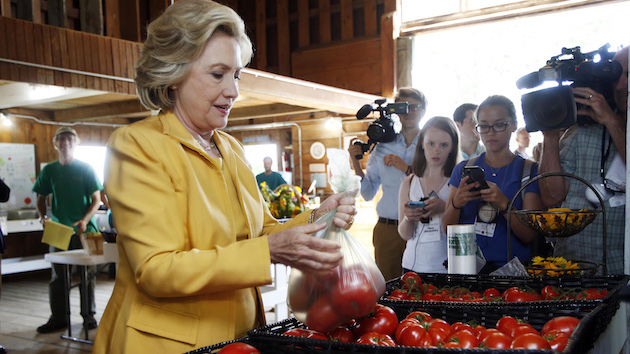
<a href="https://www.flickr.com/photos/mcbarnicle/7437249268/in/photolist-ckcR6E-7aZFhn-7aZEiR-7aZFPD-q4RX4s-87P5qP-7b4wDS-eivitw-fSHNP3-vC5xJN-ptorXa-7aZECP-7aZFye-f4QUZc-87RLXh-2AzJfG-7aZH2e-q4Z4Mp-rnDsQn-qReHSB-5acYvm-BF2Dr-5m7TUV-9N8g6b-7b4xuQ-7b4yd5-8AniQb-7iWm75-7b4w6N-bTwp2k-ckcJhL-7aZHRM-7b4ywb-6Ua9Si-ckcPAA-rdAcAY-fg5z49-ckcHbS-7b4xN3-pbc6J8-7aZHA8-dYNbeG-48nCCf-avvpNc-7j3vGb-8SehwN-7CvNxi-bs6TdS-akMYA5-5m7TVe"> SMcGarnigle</a>/Flickr
Spring is upon us, which means the weather is finally nice enough to sit outside and munch on a grilled burger slathered with ketchup. Or, if you prefer, a crispy salad topped with strawberries and walnuts. Either way, chances are that at least a few of the ingredients in your meal were grown in California—the country’s cornucopia. The Golden State cultivates more than a third of all vegetables and two-thirds of all fruits and nuts sold domestically. California is also home to the largest number of farmers markets and, according to the most recent USDA Organic Survey, the highest number of 100 percent organic farms of any state.
But many of the people growing and picking this food would view a fresh spring picnic as a rare luxury. A high percentage of farmworkers in California’s agricultural counties struggle with hunger and diet-related health problems, according to a new report by the policy research group California Institute for Rural Studies. Nearly half of the workers interviewed in Yolo County, just east of the state’s capital, have trouble putting dinner on the table, a rate nearly three times higher than national and state averages.
“Ironically, the same agricultural workers who are responsible for producing an abundance of food find themselves at serious risk of hunger, diet-related chronic diseases, unsafe living and working conditions, and inadequate access to health care,” the report states.
Yolo County is just east of Sacramento and encompasses the headquarters of the Mariani Nut Company, one of the biggest privately held walnut and almond producers in the world, and Rominger Brothers Farms, subject of this profile by former New York Times columnist Mark Bittman. Yolo is the state’s largest producer of safflower, used to make vegetable oil, and the state’s third-largest producer of grain.
The area is best known for its tomatoes. A whopping 96 percent of the United States’ processing tomatoes—which are used in pizza sauce, ketchup, and soup—are grown in California, and Yolo is the second-largest producer in the state. When asked what they would buy if money were no object, the workers surveyed listed tomatoes over all other fruits and vegetable. Yet, as the CIRS report notes, though tomatoes are a staple for many of the Latino farm workers employed there, those very same workers cannot always afford to buy them locally.
Almost one-third of the farmworkers CIRS interviewed said they didn’t have enough food to eat a balanced and nutritious diet regularly, and 15 percent had to eat less or stop eating because there wasn’t enough money for food. Two previous surveys by the California Institute for Rural Studies have also shown that workers in Fresno County and Salinas, which are located south of Yolo, also face high rates of hunger. Fresno is known for its almonds and grapes, while the coastal region of Salinas produces much of the nation’s lettuce and strawberries.
Part of the reason farmworkers have trouble accessing nutritious food in these agricultural areas may have to do with geography. Rural Yolo County qualifies as a food desert, with vast stretches lacking any supermarkets. Yolo County Food Bank serves about 47,000 people per month and more than a quarter of its stock is fresh produce, but there are still stretches in the county’s rural northwest, where 40 percent of the farmworkers surveyed live, that the food bank doesn’t serve, because the program tends to focus on more urban areas.
Access to healthy food is also deeply tied to low earnings and the undocumented status of many farmers. Farm workers nationwide make an average salary of just $13,000. And about half of California’s farmworkers are undocumented. Many don’t apply for food assistance programs, the study found, because they are afraid of getting detained or deported.
While California farm workers struggle to fill their pantries, their employers are busy stocking kitchens across the globe. California produces more than 400 different types of foods, from berries and celery to milk and almonds, and exports them to many different countries, including the European Union, Canada, China, India, and Turkey. According to the latest USDA figures, in 2014, nearly 16 percent of total US agricultural exports abroad originated in California, the highest of any state. (Iowa came in second at just 7.5 percent.)
Given the success of the agricultural industry in California, says Gail Wadsworth, co-executive director of CIRS and one of the authors of the report, there’s no reason why farmworkers should get the short end of the stick. CIRS has advised the Yolo Food Bank to encourage more farms to contribute fresh food to the food bank or directly to their workers. Says Wadsworth: “I don’t see any rational reason why farmworkers, who are essential to every American’s well-being, should be so poorly paid.”

















